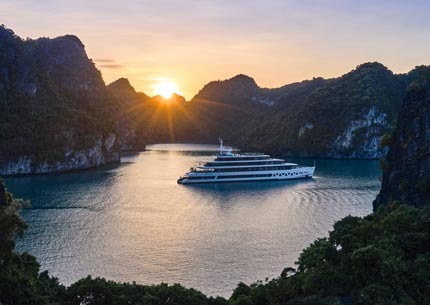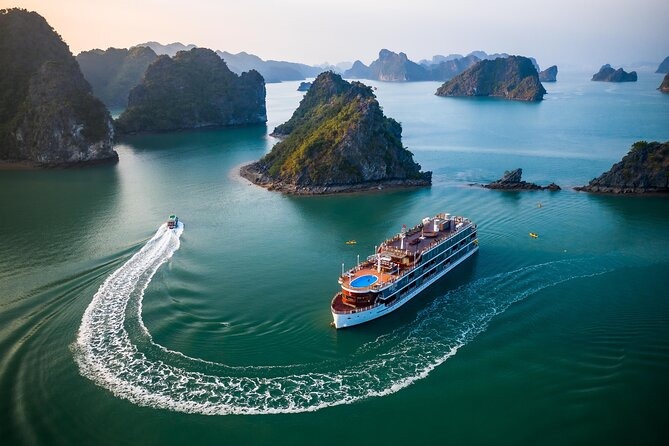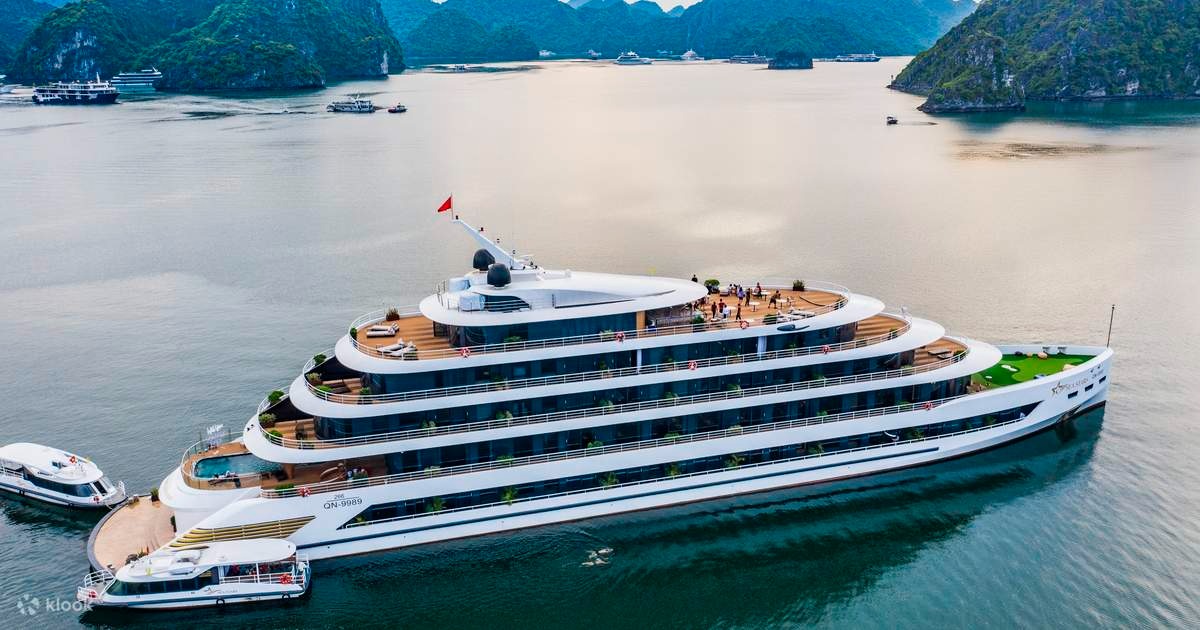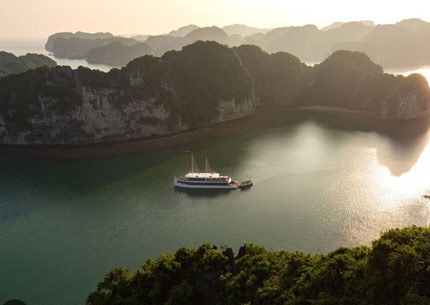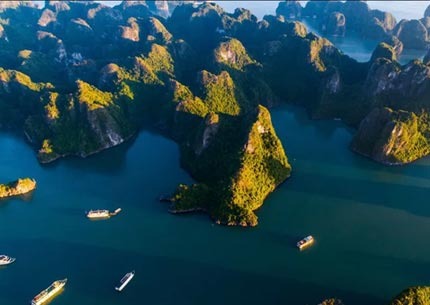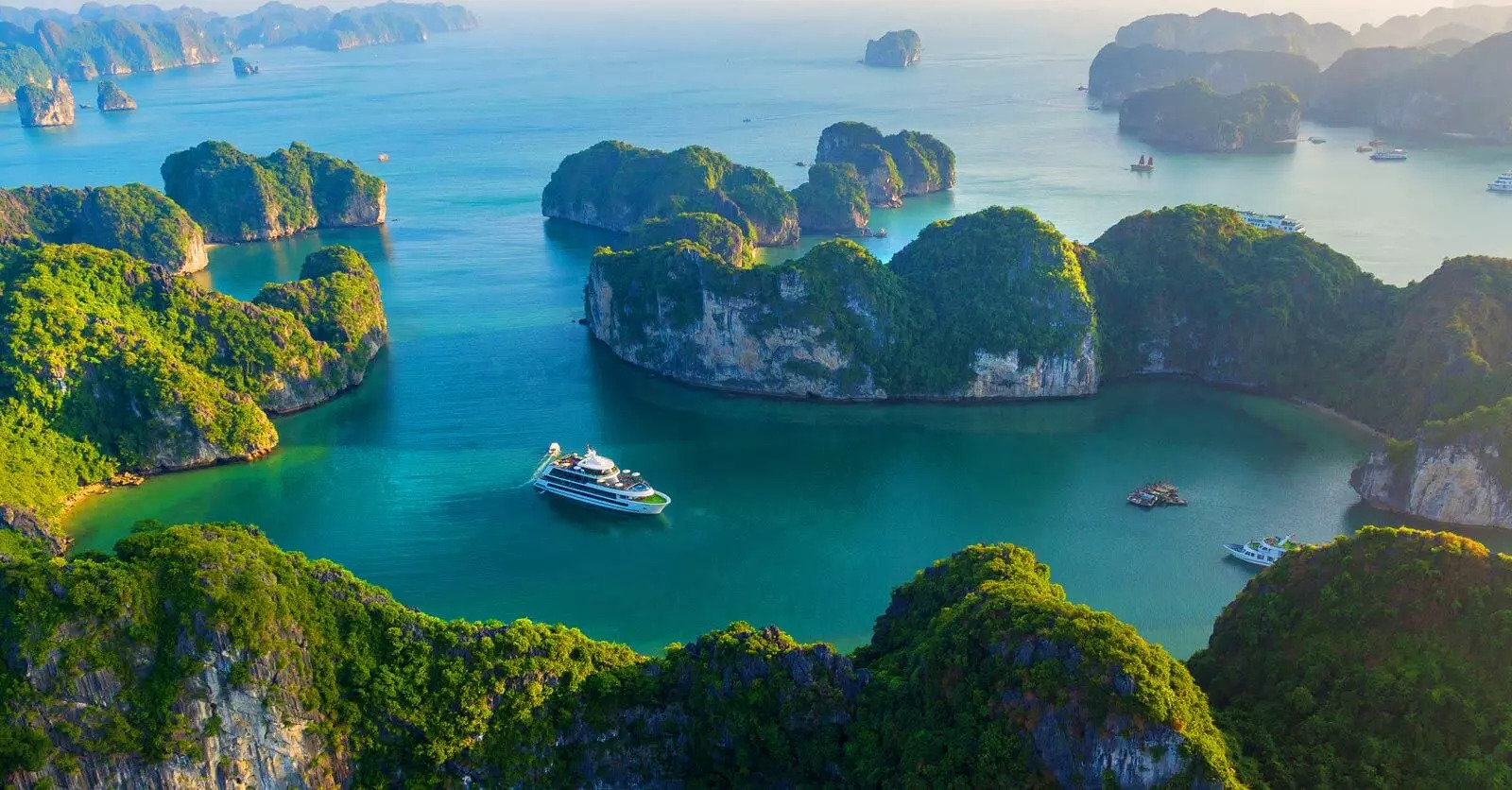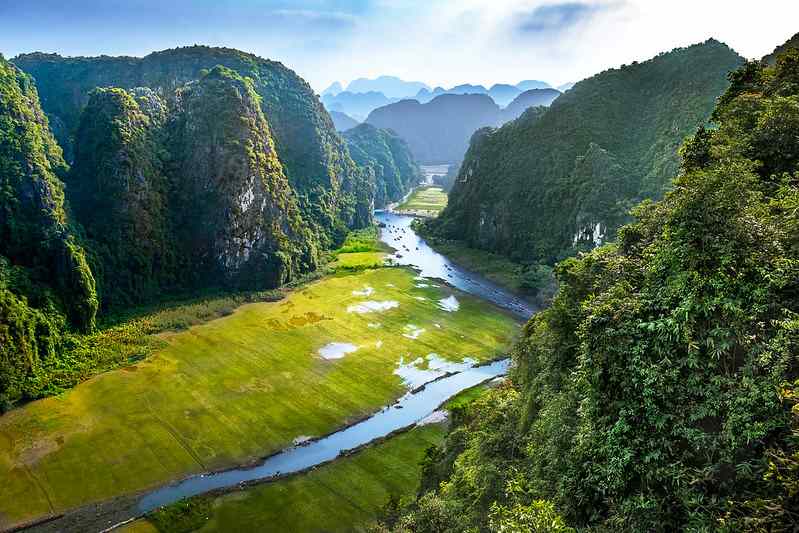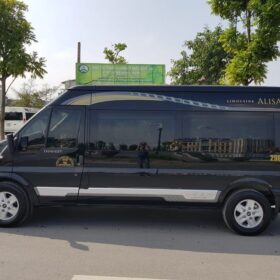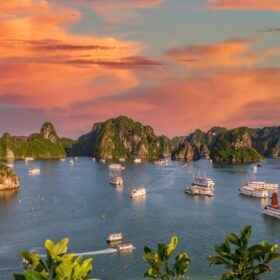13 Best Snorkeling Spots in Ha Long Bay: Ultimate Guide for 2025/26
Discover Vietnam’s underwater paradise with our comprehensive guide to snorkeling in Ha Long Bay – from hidden coves to vibrant marine ecosystems
Ha Long Bay’s emerald waters conceal a mesmerizing underwater world that remains largely unexplored by the average tourist. While the UNESCO World Heritage Site is renowned for its towering limestone karsts and scenic cruises, the aquatic realm beneath the surface offers equally breathtaking adventures. As conservation efforts intensify and water quality improves, 2025 marks an exceptional year to discover snorkeling in Ha Long Bay – an activity rapidly gaining popularity among nature enthusiasts and adventure seekers alike.
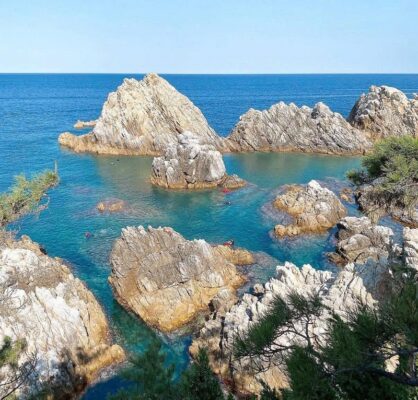
Why Ha Long Bay Snorkeling Has Transformed.
Ha Long Bay’s underwater landscape has undergone remarkable changes in recent years. The Vietnamese government’s ambitious marine conservation initiative, launched in 2023, has already shown promising results by 2025. The program focuses on reducing plastic pollution, limiting boat traffic in sensitive areas, and establishing protected marine zones where coral reefs can flourish.
These conservation efforts have dramatically improved water clarity in select areas, with visibility now reaching up to 8-10 meters during optimal conditions – a significant improvement from the 3-4 meter visibility common in previous years. The Bay’s biodiversity has also rebounded, with marine biologists documenting a 27% increase in fish species since 2022.
The bay’s unique geography – encompassing 1,969 limestone islands and islets spread across 1,553 square kilometers – creates countless sheltered coves and lagoons perfect for snorkeling adventures. These natural formations protect snorkelers from strong currents while creating diverse microhabitats for marine life.
Improvement Highlights:
- Increased water visibility (up to 8-10 meters in prime locations)
- 27% more fish species compared to 2022
- 12 new designated snorkeling zones with mooring buoys to prevent anchor damage
- Stricter environmental regulations for tour operators
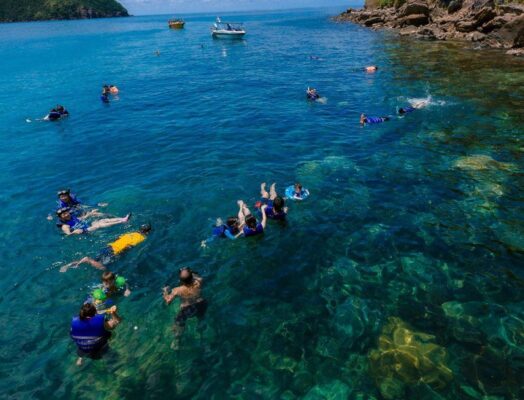
13 Must-Visit Snorkeling Spots in Ha Long Bay for 2025
1. Cong Do Area – The Coral Wonderland
Nestled in the less-crowded Bai Tu Long Bay section, Cong Do boasts the bay’s most extensive coral reef system. The sheltered location features shallow waters ranging from 1.5 to 4 meters deep, with exceptional visibility reaching 7-8 meters during calm days.
The area’s highlight is the “Coral Garden” – a 2.3-hectare zone where ongoing coral restoration projects have created a thriving ecosystem. Here, you’ll encounter vibrant staghorn corals, massive brain corals, and delicate sea fans providing habitat for clownfish, angelfish, and butterflyfish. The Vietnamese Institute of Oceanography documented over 67 fish species in this single location in their 2024 marine survey.
Marine biologist Dr. Nguyen Van Minh notes: “Cong Do represents Ha Long Bay’s most successful marine conservation story. The reef structure has shown remarkable resilience, with coral coverage increasing by 18% since our conservation efforts began.”
2. Vung Ha Island – The Pristine Paradise
Located in the eastern section of Ha Long Bay, Vung Ha Island remains one of the bay’s best-kept secrets. This hidden gem features crystal-clear waters with visibility often exceeding 9 meters and healthy coral gardens extending from 1 to 5 meters deep.
What makes Vung Ha special is its limited accessibility – only select cruise operators with environmental permits can visit, resulting in minimal human impact. The result is an untouched underwater landscape where soft corals flourish alongside hard coral formations.
The island’s northern cove, locally known as “Mermaid Lagoon,” hosts an impressive collection of table corals and elkhorn formations. Snorkelers regularly spot parrotfish, triggerfish, and occasional visits from small blacktip reef sharks that patrol the deeper edges of the reef.
3. Van Boi Beach (Cat Ba Island) – Family-Friendly Discovery
Situated on Cat Ba Island’s southern coastline, Van Boi Beach offers ideal conditions for beginner snorkelers and families. The 300-meter crescent-shaped beach features a gradual slope into clear waters with depths ranging from 1 to 3 meters.
The sandy bottom transitions to scattered coral bommies approximately 50 meters from shore, creating perfect exploration opportunities for snorkelers of all skill levels. The protected bay experiences minimal waves and currents, with water temperatures averaging a comfortable 26-28°C (79-82°F) during peak season.
Marine highlights include schools of damselfish, colorful wrasses, and the occasional cuttlefish hiding among seagrass patches. The beach’s accessibility makes it perfect for half-day excursions from Cat Ba Town, just 12 kilometers away.
4. Ba Ham Lake – The Mystical Grotto Experience
Ba Ham Lake isn’t just a snorkeling site; it’s an otherworldly adventure. This unique location consists of three interconnected lakes surrounded by vertical limestone cliffs and accessible only through narrow limestone tunnels during specific tide conditions.
The most remarkable aspect of snorkeling here is the ethereal light filtering through cavern entrances, creating dramatic underwater light shows. While coral coverage is minimal, the geological features – underwater limestone formations, hidden grottoes, and stalactite-like structures – compensate with their uniqueness.
The enclosed nature of Ba Ham creates a sheltered environment where visibility can reach 6-7 meters on calm days. Look for unique cave-dwelling species like the Ha Long goby fish and specialized invertebrates that have adapted to this unusual ecosystem.
5. Hang Trai Island – The Drift Snorkel Experience
For more adventurous snorkelers, Hang Trai Island offers Ha Long Bay’s premier drift snorkeling experience. The channel between Hang Trai and adjacent Con Coc Island features a gentle current that carries snorkelers effortlessly along a 400-meter route rich with marine life.
The drift begins at “Eagle Point” where the current is minimal, allowing snorkelers to acclimate before the gentle flow picks up. As you drift, you’ll pass over garden eels, colorful sea fans, and schooling fusiliers. The channel reaches depths of 6-8 meters, but the exceptional visibility (up to 10 meters in optimal conditions) creates the sensation of flying over an underwater landscape.
Local guide Tran Minh explains: “The Hang Trai drift is special because the current does all the work. You simply float and observe as the underwater scenery changes from sandy patches to vibrant reef sections.”
6. Three Peach Beach (Ba Trai Dao) – The Photographer’s Paradise
This picturesque location, named after three small islands resembling peaches, offers perhaps the most photogenic snorkeling in all of Ha Long Bay. The crystal-clear waters surrounding these islets feature visibility often exceeding 8 meters, with a sandy bottom gradually sloping to coral gardens at 3-5 meters depth.
What makes Three Peach Beach exceptional for underwater photography is the interplay of light. The bay’s orientation allows morning sunlight to penetrate deeply, illuminating the underwater landscape and creating perfect conditions for photography between 9am and 11am.
The area is home to particularly vibrant soft corals in shades of purple, orange, and blue – creating stunning foreground elements with the limestone karsts visible in the background when shooting split-level photographs.
7. Titov Island Reef – The Accessible Gem
Titov Island is among Ha Long Bay’s most visited destinations, famous for its panoramic viewpoint. However, few visitors explore the reef system extending from the island’s northern shore – a mistake in 2025 as recent conservation efforts have transformed this area.
The newly established snorkeling zone, marked by buoys 100 meters from shore, protects a rejuvenating reef system spanning 1.8 hectares. The Vietnamese Marine Conservation Association has been actively transplanting coral fragments here since 2023, resulting in impressive recovery with coral coverage increasing by 23% in just two years.
The site’s accessibility – featured on almost all cruise itineraries – makes it an easy addition to standard Ha Long Bay tours. Expect to see butterfly fish, sergeant majors, and colorful christmas tree worms embedded in the growing coral structures.
8. Cua Van Floating Village Waters – The Cultural Immersion
Snorkeling near the Cua Van floating village offers a unique blend of cultural and natural exploration. This area, where approximately 300 people traditionally lived on floating homes (though now mostly relocated to land), features a marine ecosystem adapted to human presence.
The waters around the village’s periphery host artificial reef structures created from sunken boats and bamboo frames. These structures, some dating back decades, have developed into thriving mini-ecosystems populated by groupers, snappers, and a surprising diversity of nudibranchs (sea slugs).
Snorkeling here during morning hours allows you to observe local fishermen using traditional methods to catch squid and small fish – providing a glimpse into the bay’s human-ocean relationship that spans generations.
9. Tung Sau Pearl Farm – The Cultivated Marine Garden
For something completely different, the waters surrounding Tung Sau Pearl Farm offer a glimpse into cultivated marine environments. This working pearl farm, covering approximately 40 hectares, creates a protected zone where marine life thrives among the pearl-growing structures.
Snorkeling here allows observation of the pearl cultivation process while enjoying surprisingly diverse marine life attracted to the suspended oyster baskets. The farm’s strict water quality requirements have resulted in exceptionally clear conditions, with visibility regularly exceeding 7 meters.
Look for juvenile fish using the structures as nursery grounds, along with specialized filter feeders and occasional seahorses clinging to the cultivation lines. The site’s management permits snorkeling in designated areas between 10am and 3pm daily.
10. Luon Cave Entrance – The Transition Zone Adventure
The mouth of Luon Cave presents one of Ha Long Bay’s most interesting snorkeling opportunities. This area represents a transition zone where the open bay meets a sheltered interior lagoon, creating a unique environment where multiple ecosystems converge.
The entrance features a shallow reef flat (1-3 meters deep) that gives way to a dramatic drop-off reaching depths of 8-10 meters inside the cavern. The contrast between sunlit waters and the shadowy cave interior creates striking visual effects, especially during midday when sunbeams penetrate into the cavern.
Marine life here is adapted to the varying light conditions, with sun-loving coral species near the entrance giving way to shade-tolerant invertebrates inside. The site is ideal for experienced snorkelers comfortable in varying conditions.
11. Ang Du Area – The Macro Photography Heaven
While most snorkeling spots highlight colorful fish and corals, Ang Du specializes in the small and unusual. This area, located in the southwestern section of the bay, features numerous small coves with muddy-sandy bottoms interspersed with seagrass beds and isolated coral formations.
These conditions create perfect habitat for macro life – tiny creatures that fascinate underwater photographers. Patient snorkelers can discover ornate ghost pipefish, various shrimp species, blennies, and nudibranchs in remarkable diversity. A 2024 marine survey documented 43 nudibranch species in this area alone – the highest concentration in Ha Long Bay.
The site’s sheltered location means it often remains snorkelable even when other areas experience poor conditions, making it a reliable backup option during unpredictable weather.
12. May Rut Island – The Night Snorkeling Pioneer
May Rut Island has pioneered a unique experience in Ha Long Bay – night snorkeling with special LED lighting systems. This controlled experience, available through select luxury cruises, reveals a completely different underwater world that emerges after dark.
The island’s western cove features a sandy bottom with scattered coral heads at 2-4 meters depth – ideal for this supervised activity. Specialized guides equipped with underwater lights lead small groups to observe nocturnal creatures like octopuses, squids, and various crustaceans that remain hidden during daylight hours.
The site’s organization includes illuminated boundary markers and surface support teams, making this adventure accessible even to those new to night water activities. The experience concludes with a unique spectacle – bioluminescent plankton that create trails of blue light when disturbed in the water.
13. Dao Tung Lam – The Seasonal Wonder
Our final recommended snorkeling site operates on nature’s schedule. Dao Tung Lam’s southern bay transforms seasonally, with optimal conditions occurring from late August through October when water temperatures and clarity peak simultaneously.
During these golden weeks, the site experiences a phenomenon local guides call “The Clearing” – when visibility suddenly jumps to an exceptional 10-12 meters, revealing extensive coral gardens typically obscured by Ha Long Bay’s characteristic green water.
The bay features a diverse underwater topography with depths ranging from 2 to 8 meters, including interesting swim-throughs and small caverns. The site’s remoteness in the eastern reaches of the bay means it receives few visitors, preserving both its pristine condition and sense of discovery.
When to Go: Optimal Snorkeling Seasons in Ha Long Bay
Ha Long Bay’s climate creates distinct snorkeling seasons, each offering different advantages:
Prime Season (April to June)
April through June represents the absolute sweet spot for snorkeling in Ha Long Bay. During these months, several favorable conditions converge:
- Water temperature: A comfortable 24-27°C (75-81°F)
- Average visibility: 5-8 meters (16-26 feet)
- Weather stability: Low chance of storms (7% probability in May)
- Wind conditions: Gentle breezes averaging 6-8 knots
These spring months also coincide with phytoplankton blooms that attract feeding fish, increasing marine life sightings by approximately 30% compared to other seasons, according to local marine guides.
Secondary Peak (September to October)
The early autumn months offer another excellent window for underwater exploration:
- Water temperature: Warm at 26-29°C (79-84°F)
- Average visibility: 4-7 meters (13-23 feet)
- Tourist density: 35% fewer visitors than peak summer
- Special events: Coral spawning events occasionally visible in late September
Marine biologist Dr. Lan Phuong notes: “The September-October period often surprises visitors with exceptional clarity after the summer rains wash out. The slightly reduced tourist numbers mean snorkeling sites are less crowded, creating more intimate wildlife encounters.”
Challenging Period (July to August)
While summer represents peak tourism season, it presents challenges for snorkelers:
- Storm risk: 22% chance of tropical storm systems
- Reduced visibility: Often limited to 2-4 meters due to runoff
- Higher boat traffic: Increased sediment disturbance
- Water temperature: Sometimes uncomfortably warm at 28-31°C (82-88°F)
If visiting during this period, morning snorkeling sessions offer better conditions before afternoon winds typically intensify.
Winter Considerations (November to March)
Winter brings cooler conditions but occasional advantages:
- Water temperature: Cooler at 18-22°C (64-72°F), requiring 3mm wetsuits
- Visibility variables: Can range from poor (2m) to surprisingly good (6m)
- Wind factor: Stronger northeast monsoon winds (12-15 knots average)
- Unique advantage: Fewer jellyfish present than in warmer months
Local snorkeling guide Nguyen Thi Hanh advises: “Experienced snorkelers visiting in winter should target protected southern bays that block the northeast winds. Water clarity can actually be excellent on calm days, with fewer tourists competing for space.”
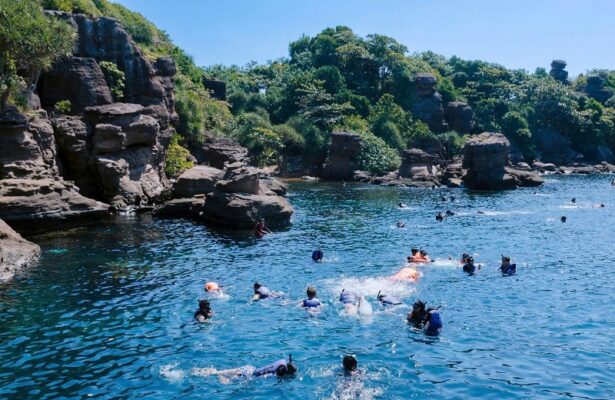
Essential Gear and Preparation for Ha Long Bay Snorkeling
Recommended Equipment for 2025 Conditions
The unique conditions of Ha Long Bay require specific gear considerations:
- Mask and Snorkel: Full-face snorkel masks are increasingly popular for beginners in Ha Long Bay, allowing easier breathing without water entry. Traditional mask-snorkel combinations offer better customization for experienced snorkelers.
- Fins: Short, flexible fins work best for Ha Long Bay’s varied conditions, allowing easier navigation in confined spaces around limestone formations. Pack fins that fit comfortably with neoprene socks to prevent chafing.
- Exposure Protection: A 1-3mm shorty wetsuit is ideal for most of the year, providing both thermal regulation and protection from occasional jellyfish or sharp coral. During winter months (November-March), upgrade to a full 3mm wetsuit.
- UV Protection: The bay’s waters reflect sunlight intensely. Beyond sunscreen, consider a lycra rash guard with UPF 50+ protection and a wide-brimmed hat for boat transits.
- Personal Flotation: Even strong swimmers should consider a snorkel vest in Ha Long Bay, as currents can change unexpectedly around islands and channels.
What Tour Operators Typically Provide vs. What to Bring
Most reputable tour operators in 2025 provide basic snorkeling equipment, but quality and sizing vary significantly:
Typically Provided:
- Basic masks and snorkels (usually one-size-fits-all)
- Standard fins (limited size range)
- Life jackets (mandatory for boat transfers)
- Basic instruction for beginners
Recommended to Bring:
- Your own mask and snorkel (for proper fit and hygiene)
- Prescription masks if needed (not available for rent)
- Underwater camera with floating wrist strap
- Dry bag for personal items (10-15L capacity ideal)
- Reef-safe sunscreen (oxybenzone-free formula)
Ha Long Bay’s premier operator, Ha Long Bay Lux Cruises, offers premium gear rental options including optical masks and high-quality fins not typically available from standard providers.
Marine Life Encounters: What You’ll See Underwater
Ha Long Bay’s underwater biodiversity might surprise visitors expecting limited marine life. The complex ecosystem supports hundreds of species adapted to the bay’s unique conditions.
Common Fish Species
The bay hosts over 200 fish species, with these being most frequently encountered by snorkelers:
- Damselfish: The electric blue damselfish (Pomacentrus coelestis) schools in groups of 20-30 around shallow coral formations, creating vibrant flashes of color.
- Butterflyfish: Several species inhabit the bay, including the distinctive Raccoon Butterflyfish (Chaetodon lunula) with its black “mask” pattern and the Threadfin Butterflyfish (Chaetodon auriga) with its elegant trailing filament.
- Parrotfish: The Bluebarred Parrotfish (Scarus ghobban) grows up to 70cm and can be spotted grazing on algae-covered rocks, their distinctive beak-like mouths constantly working.
- Groupers: Smaller species like the Honeycomb Grouper (Epinephelus merra) with its distinctive spotted pattern hide among reef crevices.
- Wrasses: The Cleaner Wrasse (Labroides dimidiatus) establishes “cleaning stations” where larger fish visit to have parasites removed – a fascinating behavior easily observed by patient snorkelers.
Coral Formations
While not as extensive as some tropical destinations, Ha Long Bay’s coral gardens display remarkable diversity:
- Massive Corals: Brain corals (Platygyra sp.) form distinctive maze-like patterns and can grow to 1-2 meters in diameter in protected areas.
- Branching Corals: Staghorn coral (Acropora sp.) creates complex three-dimensional habitats in shallow, clear waters, particularly around Cong Do Island.
- Soft Corals: Colorful sea fans and flexible soft corals add splashes of purple, red, and orange to underwater landscapes, especially notable around Three Peach Beach.
- Table Corals: Flat, table-like formations provide shelter for juvenile fish species and add architectural diversity to reef systems.
Fascinating Invertebrates
Some of the bay’s most interesting encounters involve creatures without backbones:
- Giant Clams: Tridacna species reaching 30-40cm display electric blue, green, or purple mantles when open in sunny locations.
- Nudibranchs: These colorful sea slugs come in psychedelic patterns and vibrant colors. Ha Long Bay hosts over 70 documented species, with new discoveries regularly reported.
- Sea Stars: The distinctive Blue Sea Star (Linckia laevigata) creates photogenic opportunities against sandy bottoms.
- Cuttlefish: Masters of camouflage, these intelligent cephalopods change color and texture instantly to match their surroundings. Patient snorkelers may witness their mesmerizing color displays.
Seasonal Visitors
Depending on your timing, you might encounter these special visitors:
- Sea Turtles: Green sea turtles occasionally visit the bay’s seagrass beds, particularly around Cat Ba Island’s quieter bays during April-June.
- Jellyfish: Moon jellyfish blooms sometimes occur in summer months. While their sting is mild, they create both caution and photographic opportunities.
- Seahorses: The rare spotted seahorse can be found clinging to seagrass in sheltered locations, particularly around Tung Sau area where water quality is carefully maintained.

Tour Options: From Budget to Luxury Snorkeling Experiences
Ha Long Bay offers snorkeling experiences across the price spectrum, each with distinct advantages:
Day Trip Snorkeling Tours (Budget-Friendly)
Price Range: $35-65 USD per person
Duration: 6-8 hours
Departure Points: Tuan Chau Marina, Cat Ba Island
These accessible options provide a taste of Ha Long Bay snorkeling without overnight costs. Typically departing at 8:30 AM, speedboats transport groups of 12-20 people to 2-3 snorkeling locations, returning by late afternoon.
Pros:
- Most affordable entry point to Ha Long Bay snorkeling
- No overnight commitment required
- Multiple departure times and locations
Cons:
- Limited to more accessible/crowded snorkel sites
- Less time at each location (typically 30-45 minutes)
- Larger groups mean less personalized attention
Recommended Providers: Cat Ba Ventures, Ocean Tours, Indochina Junk Day Tours
Overnight Cruise with Snorkeling Excursions (Mid-Range)
Price Range: $150-280 USD per person
Duration: 2 days/1 night or 3 days/2 nights
Departure Points: Tuan Chau Marina, Got Pier
The most popular option combines traditional Ha Long Bay cruising with dedicated snorkeling sessions. These 2-day Halong and Lan Ha Bay cruises visit further-flung locations with better visibility and fewer crowds.
Pros:
- Access to more remote snorkeling sites
- Combination of activities (kayaking, swimming, cave visits)
- Comfortable accommodation between water activities
Cons:
- Snorkeling is one of several activities, not the primary focus
- Fixed departure schedules
- Shared experience with other cruise passengers
Notable Experience: The 3-day 5-star Lan Ha Bay and Halong Bay cruise includes extended snorkeling at Three Peach Beach with dedicated marine guides who provide ecological context for underwater sightings.
Multi-Destination Snorkeling Adventures (Premium)
Price Range: $350-500 USD per person
Duration: 3-5 days
Itinerary Type: Combined destinations
For serious snorkeling enthusiasts, these comprehensive packages combine Ha Long Bay with other destinations like Ninh Binh or Cat Ba National Park. The Ninh Binh-Halong Bay 3-day package alternates landscape and underwater exploration for a complete Northern Vietnam experience.
Pros:
- Diverse snorkeling environments across multiple locations
- Professional guides specializing in marine ecology
- Smaller groups (typically 4-8 participants)
Cons:
- Higher price point
- Requires more vacation time
- More logistically complex with multiple transfers
Special Feature: These tours often include special experiences unavailable elsewhere, such as night snorkeling sessions and visits to conservation projects working on coral restoration.
Private Charters with Customized Snorkeling (Luxury)
Price Range: $600-1,200 USD per day (total charter, not per person)
Group Size: Your private party (typically up to 12 people)
Customization: Fully tailored itinerary
The ultimate Ha Long Bay snorkeling experience involves chartering a private boat with dedicated crew and snorkeling guide. This option allows complete customization of sites, timing, and activities.
Pros:
- Visit snorkeling sites during optimal conditions and times
- Adjust schedule based on weather and visibility
- Personalized instruction for beginners
- Total privacy and exclusivity
Cons:
- Significant premium over group tours
- Requires advance booking (3+ months recommended for peak season)
- Minimum charter durations apply (typically 2+ days)
Elite Experience: Luxury operators like Emperor Cruises and Heritage Line offer private yacht charters with onboard marine biologists who can provide scientific context to snorkeling explorations and help identify rare species.
Safety Considerations and Environmental Responsibility
Staying Safe While Snorkeling in Ha Long Bay
The bay’s unique environment presents specific safety considerations:
- Tidal Awareness: Ha Long Bay experiences tidal fluctuations of 3-4 meters. Certain sites like Ba Ham Lake are only accessible during specific tide conditions. Always follow guide recommendations about timing.
- Boat Traffic: The bay hosts significant vessel traffic. Snorkeling areas should use marker buoys and supervising boats should display international “divers down” flags. Always stay within designated snorkeling zones.
- Current Variations: Channels between islands can develop strong currents, especially during tide changes. Less experienced snorkelers should remain in protected bays where current is minimal.
- Marine Hazards: While serious hazards are rare, be aware of:
- Fire coral (causes skin irritation) found on shallow reef tops
- Long-spined sea urchins in rocky areas
- Occasional jellyfish blooms (May-August)
Safety Statistics: According to the Ha Long Bay Management Board, snorkeling incidents remain extremely rare, with zero serious injuries reported among guided snorkeling groups in 2023-2024.
Environmental Protection Measures for Responsible Tourism
Ha Long Bay’s ecosystem requires conscientious visitors:
- Reef-Safe Sunscreen Requirement: As of January 2025, all tour operators in Ha Long Bay must provide or require reef-safe sunscreen. Conventional sunscreens containing oxybenzone and octinoxate are officially banned as they damage coral polyps.
- No-Touch Policy: Maintaining a minimum 2-meter distance from coral formations prevents accidental damage from fins or hands. Never stand on or touch coral – even dead coral provides essential habitat.
- Plastic Reduction Initiative: All snorkeling tours now provide reusable water bottles as part of government-mandated plastic reduction. Refill stations are available on most boats.
- Conservation Contribution: A portion of all Ha Long Bay entrance fees (approximately $3 USD per visitor) directly funds marine conservation projects, including coral nurseries and water quality monitoring.
Environmental scientist Dr. Pham Thu Thuy explains: “Every snorkeler in Ha Long Bay becomes part of our conservation story. By following guidelines and supporting eco-conscious operators, visitors help preserve this underwater heritage for future generations.”
Planning Your Perfect Ha Long Bay Snorkeling Adventure
Step-by-Step Booking Guide for 2025
- Determine Your Snorkeling Priority Level:
- Primary activity (dedicated snorkeling tour)
- Important activity (cruise with multiple snorkeling sessions)
- Casual activity (standard cruise with one snorkeling opportunity)
- Select Optimal Timing:
- April-June for ideal conditions
- September-October for fewer crowds
- Consider 3-day itineraries to maximize chances of good visibility
- Choose Tour Type Based on Experience Level:
- Beginners: Overnight cruise with morning snorkeling sessions
- Intermediate: 3-day cruise with multiple snorkeling locations
- Advanced: Specialized snorkeling-focused tour or private charter
- Book Well in Advance:
- Peak season (April-October): 3+ months ahead
- Premium operators like Ha Long Bay Lux Cruises often sell out 4-5 months in advance
- Last-minute bookings typically result in limited options and higher prices
- Prepare Necessary Items:
- Personal snorkeling gear if preferred
- Quick-dry clothing for between sessions
- Waterproof camera or phone case
- Cash for optional activities or guide gratuities
Combining Snorkeling with Other Ha Long Bay Experiences
The most satisfying itineraries balance underwater exploration with other iconic activities:
- Morning Snorkeling + Afternoon Cave Exploration: Morning typically offers calmer waters and better visibility, making it ideal for snorkeling. Afternoon cave visits provide cooling respite and cultural context.
- Kayaking to Snorkel Sites: Some locations like Van Boi Beach can be accessed via kayak, creating a dual adventure. The 3-day Lan Ha and Ha Long Bay cruise offers this popular combination.
- Snorkeling + Floating Village Cultural Visit: Understanding the bay’s human heritage complements its natural wonders. Combining morning snorkeling with afternoon visits to Cua Van or Vung Vieng floating villages creates a comprehensive experience.
- Multi-Destination Northern Vietnam Circuit: The ultimate northern Vietnam experience combines Ha Long Bay snorkeling with trekking in Ninh Binh’s limestone landscapes. The Ninh Binh-Halong Bay 3-day package perfectly balances these complementary destinations.
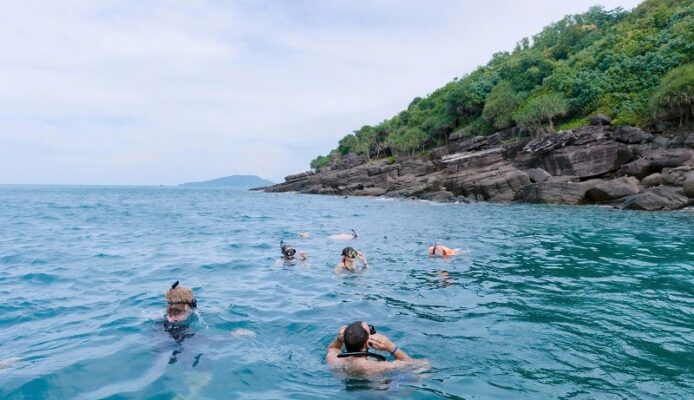
Frequently Asked Questions About Snorkeling in Ha Long Bay
Is Ha Long Bay good for snorkeling?
Yes, Ha Long Bay offers rewarding snorkeling experiences, particularly in 2025 as water quality improvements continue. While not comparable to tropical reef systems like those in Thailand or the Philippines, the bay provides unique snorkeling opportunities combining geological wonders with marine life. The best locations offer visibility up to 8-10 meters with surprising biodiversity including colorful reef fish, soft corals, and fascinating invertebrates.
Do I need to know how to swim to go snorkeling in Ha Long Bay?
Basic swimming ability is recommended but not absolutely required. Most tour operators provide flotation devices and conduct snorkeling in calm, protected areas. Non-swimmers should:
- Always inform guides of swimming limitations
- Use a buoyancy aid (snorkel vest or life jacket)
- Consider a full-face snorkel mask for easier breathing
- Stay within arm’s reach of a guide or boat
When is the best time of day to snorkel in Ha Long Bay?
Morning sessions between 8:30 AM and 11:00 AM typically offer optimal conditions. This timing provides:
- Calmer waters before afternoon winds
- Better underwater visibility
- Softer, more photogenic lighting
- More active fish behavior
Afternoon snorkeling can still be enjoyable but may experience more boat traffic and wind-generated waves.
Can children go snorkeling in Ha Long Bay?
Yes, children as young as 6 years old can enjoy snorkeling in selected locations. Family-friendly sites like Van Boi Beach and Titov Island offer shallow, protected waters ideal for young snorkelers. Look for:
- Tours specifically labeled “family-friendly”
- Operators providing child-sized equipment
- Locations with gradual entry from beaches
- Guides experienced with children
How does snorkeling in Ha Long Bay compare to other Southeast Asian destinations?
Ha Long Bay offers a distinctive snorkeling experience focused on unique geology rather than extensive coral reefs. Compared to other destinations:
- Thailand (Koh Tao, Similan Islands): These locations offer greater marine biodiversity and coral coverage but lack Ha Long Bay’s dramatic limestone backdrops.
- Philippines (Coron, El Nido): Most similar to Ha Long Bay with karst formations, but with clearer waters and more extensive reef systems.
- Indonesia (Raja Ampat, Komodo): Significantly higher marine biodiversity but requires more advanced snorkeling skills and access logistics.
Ha Long Bay’s advantage is its accessibility combined with the unique experience of snorkeling among UNESCO-recognized limestone formations.
Is it safe to snorkel independently in Ha Long Bay?
Independent snorkeling is not recommended in Ha Long Bay for several reasons:
- Navigation challenges among the 1,969 similar-looking islands
- Changing tidal conditions affecting currents
- Busy boat traffic creating safety hazards
- Difficulty accessing prime snorkeling sites without proper transportation
- Protected area regulations requiring official guides in many zones
What camera equipment works best for Ha Long Bay snorkeling?
Underwater photography in Ha Long Bay presents unique challenges and opportunities:
- Entry-Level: Waterproof action cameras (GoPro Hero or DJI Osmo Action) work well in Ha Long Bay’s variable visibility conditions. Their wide-angle lenses capture both underwater scenes and dramatic limestone backdrops.
- Mid-Range: Compact cameras in underwater housings with external lighting (like the Olympus Tough TG-6 with underwater strobe) help overcome the bay’s sometimes limited visibility by providing controlled lighting.
- Professional: For serious underwater photographers, mirrorless cameras in housings with dual strobes can capture the bay’s unique split-level compositions showing both underwater life and iconic karst formations.
The green water characteristic of Ha Long Bay benefits from cameras with manual white balance capability to restore natural colors.
Conclusion: Is Snorkeling in Ha Long Bay Worth It ?
Snorkeling in Ha Long Bay offers a distinctive underwater adventure unlike any other in Southeast Asia. The combination of dramatic limestone karsts extending below the surface, improving water quality, and increasing marine conservation efforts makes 2025 an excellent time to explore this UNESCO World Heritage Site from a new perspective.
While not offering the extensive coral systems of tropical destinations further south, Ha Long Bay compensates with unique underwater landscapes, improving visibility, and the unmatched experience of snorkeling beneath towering limestone formations that continue underwater to create a surreal submerged world.
The bay’s numerous protected coves and lagoons ensure that even when weather affects some areas, alternative snorkeling sites remain accessible – making it a reliable addition to Northern Vietnam itineraries.
Whether you’re a seasoned snorkeler seeking new experiences or a beginner looking to explore underwater wonders in a controlled environment, Ha Long Bay’s emerging snorkeling scene deserves a place on your 2025 travel itinerary. The continuing improvements in marine protection, coupled with better-equipped tour operators and more diverse itinerary options, have transformed what was once an afterthought activity into a compelling reason to visit this natural wonder.
Ready to discover the hidden depths of Ha Long Bay? Book your 2-day luxury cruise experience today and prepare for an underwater adventure among Vietnam’s most iconic seascape.
Hotline | WhatsApp: +84.978.358.422
Phone | WhatsApp: +84.962.261.687
Email: halongbayluxcruises@gmail.com
vietnammarveltravel@gmail.com

